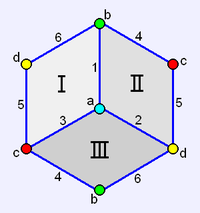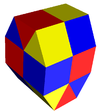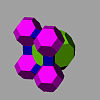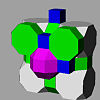- Cube
-
This article is about the geometric shape. For other uses, see Cube (disambiguation).
Regular Hexahedron 
(Click here for rotating model)Type Platonic solid Elements F = 6, E = 12
V = 8 (χ = 2)Faces by sides 6{4} Schläfli symbol {4,3} Wythoff symbol 3 | 2 4 Coxeter-Dynkin 




Symmetry Oh, [4,3], (*432) References U06, C18, W3 Properties Regular convex zonohedron Dihedral angle 90° 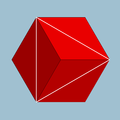
4.4.4
(Vertex figure)
Octahedron
(dual polyhedron)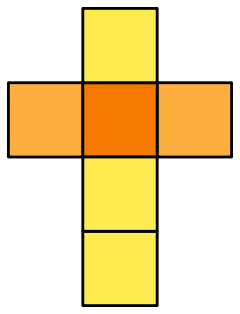
NetIn geometry, a cube[1] is a three-dimensional solid object bounded by six square faces, facets or sides, with three meeting at each vertex. The cube can also be called a regular hexahedron and is one of the five Platonic solids. It is a special kind of square prism, of rectangular parallelepiped and of trigonal trapezohedron. The cube is dual to the octahedron. It has cubical symmetry (also called octahedral symmetry). It is special by being a cuboid and a rhombohedron.
Contents
Cartesian coordinates
Orthographic projections 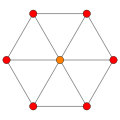
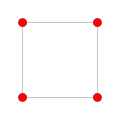
For a cube centered at the origin, with edges parallel to the axes and with an edge length of 2, the Cartesian coordinates of the vertices are
- (±1, ±1, ±1)
while the interior consists of all points (x0, x1, x2) with −1 < x i < 1.
Formulae
For a cube of edge length a,
surface area 6a2 volume a3 face diagonal 
space diagonal 
radius of circumscribed sphere 
radius of sphere tangent to edges 
radius of inscribed sphere 
angles between faces 
As the volume of a cube is the third power of its sides a×a×a, third powers are called cubes, by analogy with squares and second powers.
A cube has the largest volume among cuboids (rectangular boxes) with a given surface area. Also, a cube has the largest volume among cuboids with the same total linear size(length+width+height).
Uniform colorings and symmetry
The cube has three uniform colorings, named by the colors of the square faces around each vertex: 111, 112, 123.
The cube has three classes of symmetry, which can be represented by vertex-transitive coloring the faces. The highest octahedral symmetry Oh has all the faces the same color. The dihedral symmetry D4h comes from the cube being a prism, with all four sides being the same color. The lowest symmetry D2h is also a prismatic symmetry, with sides alternating colors, so there are three colors, paired by opposite sides. Each symmetry form has a different Wythoff symbol.
Name Regular hexahedron Square prism Cuboid Trigonal trapezohedron Coxeter-Dynkin 














Schläfli symbol {4,3} {4}x{} {}x{}x{} Wythoff symbol 3 | 4 2 4 2 | 2 | 2 2 2 Symmetry Oh
(*432)D4h
(*422)D2h
(*222)D3d
(2*3)Symmetry order 24 16 8 12 Image
(uniform coloring)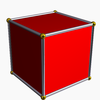
(111)
(112)
(123)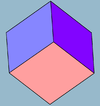
(111), (112), (122), and (222)Geometric relations
These familiar six-sided dice are cube-shaped.
A cube has 11 nets (one shown above): that is, there are 11 ways to flatten a hollow cube by cutting 7 edges.[2] To colour the cube so that no two adjacent faces have the same colour, one would need at least 3 colours.
The cube is the cell of the only regular tiling of 3 dimensional Euclidean space. It is also unique among the Platonic solids in having faces with an even number of sides and, consequently, it is the only member of that group that is a zonohedron (every face has point symmetry).
The cube can be cut into 6 identical square pyramids. If these square pyramids are then attached to the faces of a second cube, a rhombic dodecahedron is obtained (with pairs of coplanar triangles combined into rhombic faces.)
Other dimensions
The analogue of a cube in four-dimensional Euclidean space has a special name—a tesseract or hypercube. More properly, a hypercube (or n-dimensional cube or simply n-cube) is the analogue of the cube in n-dimensional Euclidean space and a tesseract is the order-4 hypercube. A hypercube is also called a measure polytope.
There are analogues of the cube in lower dimensions too: a point in dimension 0, a segment in one dimension and a square in two dimensions.
Related polyhedra
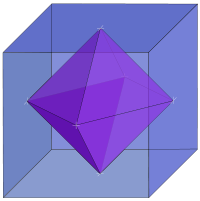 The dual of a cube is an octahedron.
The dual of a cube is an octahedron.
The quotient of the cube by the antipodal map yields a projective polyhedron, the hemicube.
If the original cube has edge length 1, its dual polyhedron (an octahedron) has edge length
 .
.The cube is a special case in various classes of general polyhedra:
Name Equal edge-lengths? Equal angles? Right angles? Cube Yes Yes Yes Rhombohedron Yes Yes No Cuboid No Yes Yes Parallelepiped No Yes No quadrilaterally faced hexahedron No No No The vertices of a cube can be grouped into two groups of four, each forming a regular tetrahedron; more generally this is referred to as a demicube. These two together form a regular compound, the stella octangula. The intersection of the two forms a regular octahedron. The symmetries of a regular tetrahedron correspond to those of a cube which map each tetrahedron to itself; the other symmetries of the cube map the two to each other.
One such regular tetrahedron has a volume of ⅓ of that of the cube. The remaining space consists of four equal irregular tetrahedra with a volume of 1/6 of that of the cube, each.
The rectified cube is the cuboctahedron. If smaller corners are cut off we get a polyhedron with 6 octagonal faces and 8 triangular ones. In particular we can get regular octagons (truncated cube). The rhombicuboctahedron is obtained by cutting off both corners and edges to the correct amount.
A cube can be inscribed in a dodecahedron so that each vertex of the cube is a vertex of the dodecahedron and each edge is a diagonal of one of the dodecahedron's faces; taking all such cubes gives rise to the regular compound of five cubes.
If two opposite corners of a cube are truncated at the depth of the 3 vertices directly connected to them, an irregular octahedron is obtained. Eight of these irregular octahedra can be attached to the triangular faces of a regular octahedron to obtain the cuboctahedron.
Related uniform polyhedra Cube





Truncated cube





cuboctahedron





Truncated octahedron





Octahedron





Rhombi-cuboctahedron





truncated cuboctahedron





Snub cube





Stella octangula














All these figures have octahedral symmetry.
The cube is a part of a sequence of rhombic polyhedra and tilings with [n,3] Coxeter group symmetry. The cube can be seen as a rhombic hexahedron where the rhombi are squares.
Polyhedra Euclidean tiling Hyperbolic tiling [3,3] [4,3] [5,3] [6,3] [7,3] [8,3] 
Cube
Rhombic dodecahedron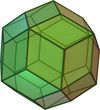
Rhombic triacontahedron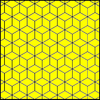
Rhombille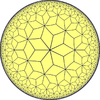

Regular and uniform compounds of cubes 
Compound of three cubes
Compound of five cubesIn uniform honeycombs and polychora
It is an element of 9 of 28 convex uniform honeycombs:
It is also an element of five four-dimensional uniform polychora:
Tesseract







Cantellated 16-cell







Runcinated tesseract







Cantitruncated 16-cell







Runcitruncated 16-cell







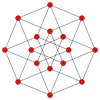

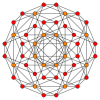
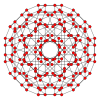
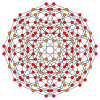
Combinatorial cubes
A different kind of cube is the cube graph, which is the graph of vertices and edges of the geometrical cube. It is a special case of the hypercube graph.
An extension is the three dimensional k-ary Hamming graph, which for k = 2 is the cube graph. Graphs of this sort occur in the theory of parallel processing in computers.
See also
- Unit cube
- Tesseract
- Cube (film)
- Trapezohedron
- Yoshimoto Cube
- The Cube (game show)
- Prince Rupert's cube
- OLAP cube
References
External links
- Weisstein, Eric W., "Cube" from MathWorld.
- Richard Klitzing, 3D convex uniform polyhedra, o3o4x - cube
- Editable printable net of a cube with interactive 3D view
- Cube: Interactive Polyhedron Model
- K.J.M. MacLean, A Geometric Analysis of the Five Platonic Solids and Other Semi-Regular Polyhedra
- The Uniform Polyhedra
- Virtual Reality Polyhedra
- Volume of a cube, with interactive animation
Polyhedron navigator Platonic solids (regular) Archimedean solids
(Semiregular/Uniform)Catalan solids
(Dual semiregular)triakis tetrahedron · rhombic dodecahedron · triakis octahedron · tetrakis cube · deltoidal icositetrahedron · disdyakis dodecahedron · pentagonal icositetrahedron · rhombic triacontahedron · triakis icosahedron · pentakis dodecahedron · deltoidal hexecontahedron · disdyakis triacontahedron · pentagonal hexecontahedronDihedral regular Dihedral uniform Duals of dihedral uniform Dihedral others Degenerate polyhedra are in italics.Fundamental convex regular and uniform polytopes in dimensions 2–10 Family An BCn Dn E6 / E7 / E8 / F4 / G2 Hn Regular polygon Triangle Square Hexagon Pentagon Uniform polyhedron Tetrahedron Octahedron • Cube Demicube Dodecahedron • Icosahedron Uniform polychoron 5-cell 16-cell • Tesseract Demitesseract 24-cell 120-cell • 600-cell Uniform 5-polytope 5-simplex 5-orthoplex • 5-cube 5-demicube Uniform 6-polytope 6-simplex 6-orthoplex • 6-cube 6-demicube 122 • 221 Uniform 7-polytope 7-simplex 7-orthoplex • 7-cube 7-demicube 132 • 231 • 321 Uniform 8-polytope 8-simplex 8-orthoplex • 8-cube 8-demicube 142 • 241 • 421 Uniform 9-polytope 9-simplex 9-orthoplex • 9-cube 9-demicube Uniform 10-polytope 10-simplex 10-orthoplex • 10-cube 10-demicube n-polytopes n-simplex n-orthoplex • n-cube n-demicube 1k2 • 2k1 • k21 pentagonal polytope Topics: Polytope families • Regular polytope • List of regular polytopes Categories:- Platonic solids
- Prismatoid polyhedra
- Space-filling polyhedra
- Volume
- Zonohedra
- Elementary shapes
- Cubes
Wikimedia Foundation. 2010.



